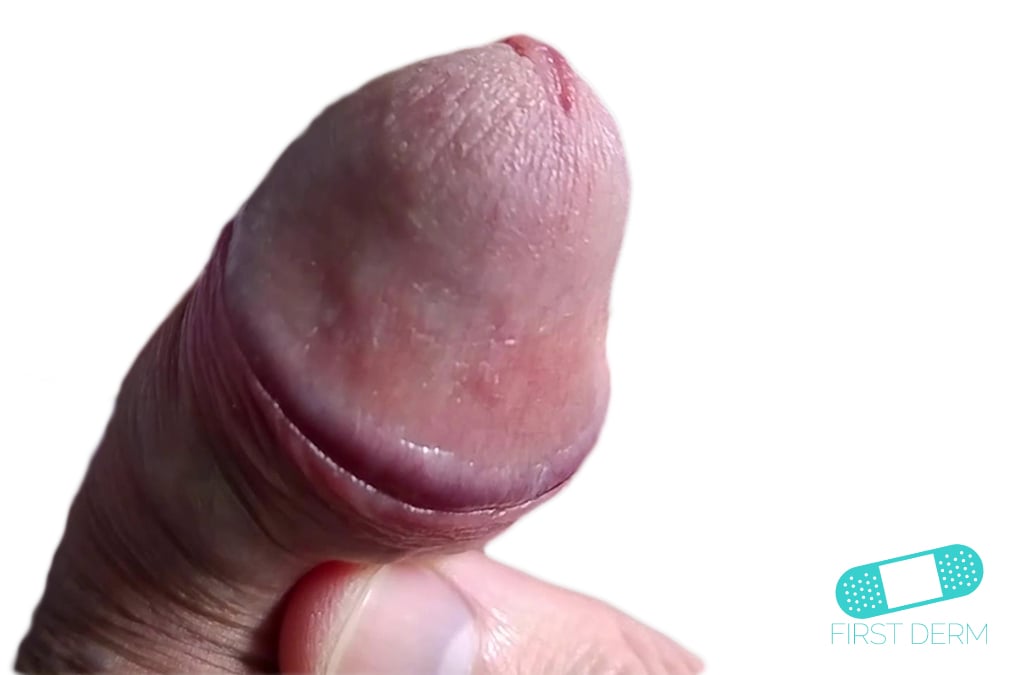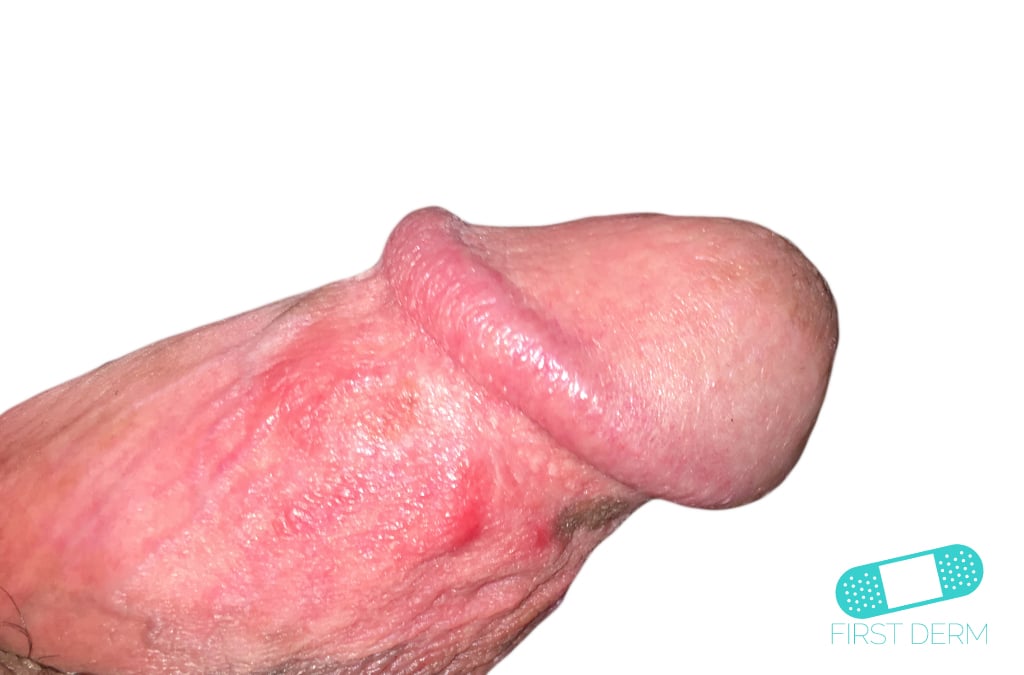Balanitis (Foreskin Problem)
Medically reviewed by The Dermatologists and written by Dr. Alexander Börve
Common
Very common, all men will have had it during their lifetime
- Medical diagnosis recommended
- Symptoms: Swelling, redness, rashes, difficulty urinating
- Color: Typically red
- Location: On the penis and foreskin
- Treatment: Steroid cream, antifungal cream, rinsing, surgery
Related Blog Posts:
Last updated on January 05, 2024
Balanitis is an inflammation of the penis, foreskin or glans and is a common problem among men, especially young boys. It is a bacterial infection in the space between the glans and the foreskin, which makes the skin of the glans irritable. The inflammation is not contagious, even though the rash itches and stings.
It is usually caused by poor hygiene. Infections, irritating soaps and diabetes are also common causes. The thin skin of the glans often cannot tolerate washing, showering or soaping several times a day.
Get peace of mind and get a home STD Lab Test today, sent discretely.
Symptoms
Swelling, redness, and rashes on the penis are common symptoms. There can be a smelly discharge, as well as pain on the penis and foreskin, especially while urinating. The foreskin opening then becomes red or pink and may be slightly push outwards. In some cases, it causes fever and difficulty in urination.

Early signs of mild balanitis (ICD-10-N51): Subtle reddish hue and minimal swelling on the penis head, indicating initial inflammation without severe lesions or sores.

Mild balanitis on the shaft below the head: Tiny raised spots with slight redness and swelling, indicating early signs of inflammatio
Different Types of Balanitis
Balanitis is a condition that can cause discomfort and symptoms on the penis head. There are mainly three types, each with its own set of symptoms:
- Zoon’s Balanitis: This is the most common form of balanitis. People usually refer to this type when they talk about the condition. It makes the head of the penis red and can be quite painful.
Early-stage symptoms of Zoon’s Balanitis (ICD-10 N51): Soft pinkish discoloration and slight swelling on the penis head, indicating the onset of inflammation without severe lesions or sores
- Circinate Balanitis: This type is linked to reactive arthritis, which is arthritis that occurs as a reaction to an infection elsewhere in the body. If you have circinate balanitis, you might notice sores along with redness and swelling on the penis head.
- Pseudoepitheliomatous Keratotic and Micaceous Balanitis: This is a rare type that mostly occurs in men older than 60. It leads to the formation of scaly warts on the penis head.
It’s also important to know about two conditions closely related to balanitis:
- Balanoposthitis: This involves the inflammation or infection of both the head of the penis and the foreskin. In contrast, balanitis specifically affects only the head of the penis.
- Phimosis: This condition happens when the foreskin can’t be pulled back from the head of the penis.
What can I do?
If the infection is mild, it is sufficient to wash the foreskin and foreskin opening two to three times a day with lukewarm water. The infection is usually cured in a few days. For the first few times you clean the affected area, you can give your child pain medications containing acetaminophen about half an hour before you clean it. While cleaning, you should bathe the child in the tub or bathtub and shower gently with weak stream around the foreskin.
You can also use a syringe of the two or five milliliters without needle and rinse the area under the foreskin with the syringe with about ten milliliters lukewarm water. With the syringe, you can easily align the beam and remove any secretions under the foreskin. You should not to pull back the foreskin of children under five while cleaning doing, as it can make the formation of scars.
You should air the affected area as much as possible. For example, you can allow a child using diapers to stop using a diaper when infected.
Get peace of mind and get a home STD Lab Test today, sent discretely.
Should I seek medical care?
If the infection is mild, the symptoms usually disappear with the help of self-treatment. If symptoms continue despite self-treatment for two to three days, you should seek medical care. You should also seek care if the infection causes fever. If the foreskin is stuck in a retracted position, you should seek medical care immediately.
Treatment
The treatment for mild symptoms consists in changing the washing habits – cleaning without soap or using an unscented one. Steroid creams or anti-fungal creams can get rid of balanitis depending on the type of condition. Treatment is important because prolonged problems can result in scarring, penile cancer, and other conditions.
If the an infection that does not disappear with the help of self-treatment, your healthcare provider can apply treatment by rinsing under the foreskin. Flushing is done by water or saline washed up under the foreskin using a syringe without a needle, which is inserted into a little under the foreskin. The flushing may hurt the first few times even though the procedure is done with a needless syringe, and in this case, an anesthetic gel can be injected under the foreskin. The affected area sometimes becomes more swollen the first few days after the treatment, and and then get better. After flushing, urinating the first few times can sting. You can normally relieve the stinging urinating penis submerged in water or in the rays of the shower. If needed, you can get a prescription of painkillers containing paracetamol.
If you have recurrent infections and also narrow foreskin, you may need surgery to prevent more infections. The surgeon can either widen the opening in the foreskin by making a small cut or remove a piece of the foreskin.
Get peace of mind and get a home STD Lab Test today, sent discretely.
Source
- Stratton KL, Dugdale DC, Conaway B, et al. Balanitis. MedlinePlus. Last reviewed July 1, 2023. Available at: https://medlineplus.gov/ency/article/000862.htm.
- Balanitis. Drugs.com. Last updated August 9, 2023. Available at: https://www.drugs.com/health-guide/balanitis.html.
- Dayal S, Sahu P. Zoon balanitis: A comprehensive review. Indian J Sex Transm Dis AIDS. 2016 Jul-Dec;37(2):129-138. doi: 10.4103/0253-7184.192128. PMID: 27890945; PMCID: PMC5111296.
Ask a Dermatologist
Anonymous, fast and secure!

The Specialist doctor from the University Hospital in Gothenburg, alumnus UC Berkeley. My doctoral dissertation is about Digital Health and I have published 5 scientific articles in teledermatology and artificial intelligence and others.



